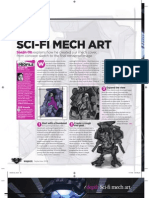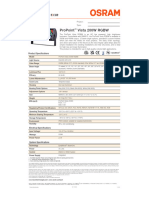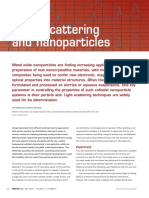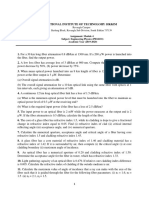The Art of Light (2017)
Uploaded by
Ryan KuradaThe Art of Light (2017)
Uploaded by
Ryan KuradaTHE ART OF LIGHT
OBJECTIVES
• Investigate properties of light—
opacity, luminosity, reflectivity
and transparency—through
EXPERIMENTING WITH LIGHT AND TRANSPARENCY hands-on experimentation.
• Act as both artists and
scientists by describing and
documenting their findings.
ESSENTIAL QUESTION
How can the properties of light
be expressed through art?
MATERIALS AND RESOURCES
• Transparent containers, bottles,
and tubes
• Light table
• Flashlights
• LCD projector
NATIONAL MEDIA ARTS
STANDARD
Producing: Develop and refine
artistic techniques and work for
presentation.
NAEYC EARLY LEARNING
PROGRAM ACCREDITATION
STANDARD
Supports or aligns to Science
2G.10.
Children constructed sculptures out of transparent materials.
Ryan Kurada
A
s a first-grade teacher who art. After traveling to the Loris
designs art-integrated proj- Malaguzzi International Center in
ect-based learning, I am Reggio Emilia and viewing their Ray
inspired by the innovative of Light Atelier exhibit, I was moti-
Children are fascinated by light.
educational philosophy that orig- vated to develop and implement my
inated in Reggio Emilia, Italy. own long-term project on light.
Students there are empowered to
investigate and interpret real-life Investigating Light
experiences and communicate This project stemmed from my stu-
interdisciplinary learning through dents observing an interesting reflec-
114 PART 5: New Media SCHOOLARTS COLLECTION 115
Children were excited to make light paintings, photographing stationary and moving lights in a dark room. Light and shadows from a fence were recorded.
tion (affectionately nicknamed “The Light Journals tunity to educate the greater school
Spider Web”) on our classroom wall Students took on the role of light community. There were a variety of
made by an LCD projector. This expe- scientists and artists as they docu- installations, including an experi-
rience piqued their interest in light, mented their ongoing learning in mentation area for families to take
which then led me to design a project their journals. They were able to part in. Hands-on activities used
around this topic. I encouraged them graphically represent and describe overhead projectors and light boxes.
to do research using a variety of artis- their observations and discoveries There was even a “mirror tent” and
tic processes and materials. about light. For example, following light tunnel constructed by parents.
an investigation of prisms, students The exhibit was a great way to
Drawing, Sculpting, Experimenting drew and wrote about the concept of conclude the project as it exem-
Students learned about opacity by refraction. Their light journals served plified the remarkable artistic and
drawing shadows of objects found as both a scientific notebook and art- scientific skills of my students.
on the school playground; explored ist sketchbook. More importantly, it made visible
luminosity using long-exposure pho- the interdisciplinary learning that
tography; experimented with reflec- Making Learning Visible occurred throughout the project,
tivity by creating foil-relief works; At the conclusion of the project, utilizing art as a primary vehicle for
and investigated the concept of trans- our class organized an interactive communication.
parency as they constructed sculp- light-show exhibit to showcase their
tures out of transparent containers, shadow drawings and transparent Ryan Kurada is a first-grade teacher at
University Elementary School in Rohnert A setup for light exploration. Children represented their discoveries about light. Artwork by Peighton.
bottles, and tubes. sculptures. This was also an oppor-
Park, California.
116 PART 5: New Media SCHOOLARTS COLLECTION 117
You might also like
- Steve D. Katz - Film Directing - Shot by Shot - 25th Anniversary Edition - Visualizing From Concept To Screen (2019) - Libgen - LiNo ratings yetSteve D. Katz - Film Directing - Shot by Shot - 25th Anniversary Edition - Visualizing From Concept To Screen (2019) - Libgen - Li152 pages
- Monster Hunter World Official Data HandbookNo ratings yetMonster Hunter World Official Data Handbook163 pages
- Compressed Persona 5 Official Design Works ARTBOOK by KBGNo ratings yetCompressed Persona 5 Official Design Works ARTBOOK by KBG515 pages
- The Art of Animal Drawing - Ken HultgrenNo ratings yetThe Art of Animal Drawing - Ken Hultgren136 pages
- Atelier Rorona and Totori Artbook - v1.2 (Batoto)No ratings yetAtelier Rorona and Totori Artbook - v1.2 (Batoto)35 pages
- Dream Works VETAnimation Education ResourceNo ratings yetDream Works VETAnimation Education Resource38 pages
- The Art of Cuphead (Eli Cymet - Tyler Moldehauer) (Z-Library)No ratings yetThe Art of Cuphead (Eli Cymet - Tyler Moldehauer) (Z-Library)273 pages
- PDF Persona 5 Official Design Works Artbook by KBG CompressNo ratings yetPDF Persona 5 Official Design Works Artbook by KBG Compress2 pages
- Concept Art Guide in Gaming Industry V 1 0 PDFNo ratings yetConcept Art Guide in Gaming Industry V 1 0 PDF6 pages
- The Art of Dragon Age - Inquisition - Page1No ratings yetThe Art of Dragon Age - Inquisition - Page1266 pages
- Forspoken Digital Mini Art-Book - 10 - OptimizedNo ratings yetForspoken Digital Mini Art-Book - 10 - Optimized3 pages
- 2DArtist Magazine Issue 074 February 2012No ratings yet2DArtist Magazine Issue 074 February 201287 pages
- How Valve Connects Art Direction To GameplayNo ratings yetHow Valve Connects Art Direction To Gameplay67 pages
- The Art of God of War-Dark Horse Books (2018)No ratings yetThe Art of God of War-Dark Horse Books (2018)228 pages
- Professor Risley and the Imperial Japanese Troupe: How an American Acrobat Introduced Circus to Japan--and Japan to the WestFrom EverandProfessor Risley and the Imperial Japanese Troupe: How an American Acrobat Introduced Circus to Japan--and Japan to the West4.5/5 (3)
- Air Force Office of Scientific Research Overview: AFOSR Spring Review 15 March 2011No ratings yetAir Force Office of Scientific Research Overview: AFOSR Spring Review 15 March 201157 pages
- Quantitative Analysis of UV-Vis SpectrosNo ratings yetQuantitative Analysis of UV-Vis Spectros15 pages
- Calibrating A Compound Light Microscope: MaterialsNo ratings yetCalibrating A Compound Light Microscope: Materials4 pages
- Physics Project On Total Internal ReflectionNo ratings yetPhysics Project On Total Internal Reflection8 pages
- ProPoint Vista 200W RGBW v1p7 21mar2022No ratings yetProPoint Vista 200W RGBW v1p7 21mar202210 pages
- Presented By-Sutrishna Pramanik Simran SiripuramNo ratings yetPresented By-Sutrishna Pramanik Simran Siripuram18 pages
- Complete Portable Video System - Light Weight - Led Light - 500Gb HDD DVRNo ratings yetComplete Portable Video System - Light Weight - Led Light - 500Gb HDD DVR2 pages
- Advaced Contact Lens: Pcurrent Challenges, Recent Advances and Possible Future of Contact Lens PracticeNo ratings yetAdvaced Contact Lens: Pcurrent Challenges, Recent Advances and Possible Future of Contact Lens Practice35 pages
- Service Manual: FM/MW/LW Compact Disc PlayerNo ratings yetService Manual: FM/MW/LW Compact Disc Player58 pages
- Praktikum Analisis Instrumentasi: Sem-EdxNo ratings yetPraktikum Analisis Instrumentasi: Sem-Edx25 pages
- Hydrogen Spectrum Chemistry Questions With Solutions - Docx 2No ratings yetHydrogen Spectrum Chemistry Questions With Solutions - Docx 27 pages
- Holophane Refractopack Series Brochure 1972No ratings yetHolophane Refractopack Series Brochure 19726 pages
























































































